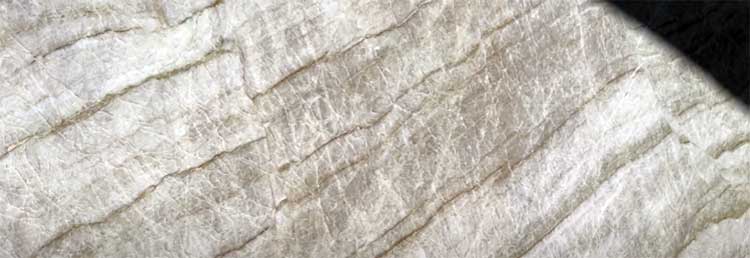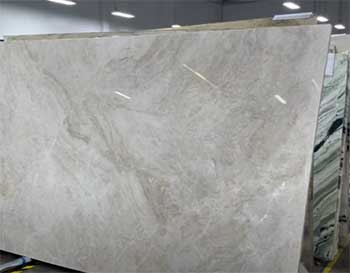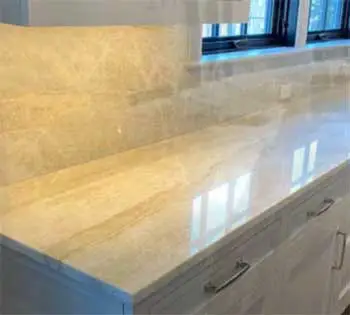I’m standing in a stone yard, surrounded by towering slabs of quartzite, each one whispering promises of elegance and durability for my kitchen remodel. My mission?
To choose between Perla Venata and Taj Mahal quartzite—two natural stones that have captured my heart and sparked endless debates among designers and homeowners. In this article, I’ll walk you through my analytical exploration of these stunning materials, comparing their aesthetics, durability, and practicalities.
You’ll get a front-row seat to my decision-making process, complete with pros, cons, and key features to help you pick the perfect stone for your space.
A Brief Comparison Table
| Feature | Perla Venata Quartzite | Taj Mahal Quartzite |
| Base Color | Creamy white to light gray | Creamy white to warm beige |
| Veining | Soft gray, subtle taupe | Gold, beige, gray, wispy |
| Tone | Cooler, serene | Warmer, inviting |
| Durability (Mohs Scale) | 7–7.5, highly durable | 7–7.5, highly durable |
| Stain Resistance | High, non-porous | High, non-porous |
| Heat Resistance | Excellent, withstands high temperatures | Excellent, withstands high temperatures |
| Maintenance | Low, seal annually | Low, seal annually |
| Cost (per sq. ft.) | $80–$120, often pricier due to rarity | $70–$100, slightly more affordable |
| Best For | Modern, minimalist, serene designs | Traditional, warm, versatile designs |
| Origin | Brazil, specific quarries | Brazil, Uruoca district |
My First Encounter With Perla Venata And Taj Mahal

Walking through the stone yard, I felt like a kid in a candy store, but instead of sweets, I was surrounded by slabs of quartzite, each with its own personality.
Perla Venata caught my eye first with its creamy white base and delicate gray veining, like a soft watercolor painting. It exuded calm, almost whispering, “I’m perfect for your modern kitchen.”
Then, Taj Mahal strutted into view, its warm beige tones and golden veins radiating a cozy, inviting vibe. I was torn. Both stones were gorgeous, but which one would truly fit my home?
Quartzite, for those unfamiliar, is a natural stone born from sandstone transformed under intense heat and pressure. It’s tougher than granite, rivals marble in beauty, and laughs in the face of scratches and stains.
Both Perla Venata and Taj Mahal are true quartzites, hailing from Brazil, but their differences in color, veining, and vibe make choosing between them a challenge. I decided to break it down analytically, weighing their aesthetics, durability, maintenance, and cost to find my perfect match.
Aesthetic Appeal: The Look That Defines Your Space
- Perla Venata’s Serene Elegance
Perla Venata is like the cool, sophisticated friend who always looks effortlessly put-together. Its base color ranges from creamy white to light gray, with soft, wispy veins in gray and subtle taupe.
The effect is serene, almost ethereal, making it a dream for minimalist or modern kitchens. I imagined it in my space, paired with sleek white cabinets and brushed brass fixtures, creating a clean, airy feel.
The stone’s neutral palette is versatile, blending seamlessly with cool or warm tones, but it leans cooler, giving it a crisp, contemporary edge.
The veining in Perla Venata is subtle, never overwhelming. Some slabs have faint taupe streaks, adding depth without stealing the show. I noticed slight variations between slabs—some were whiter, others had more pronounced gray veins.
This uniqueness is part of its charm, but it means you’ll want to hand-pick your slab to ensure it matches your vision. In my case, I was drawn to a slab with minimal veining for a clean, uniform look, perfect for my open-concept kitchen.
- Taj Mahal’s Warm Embrace
Taj Mahal, on the other hand, feels like a warm hug. Its creamy white to beige base is laced with delicate veins in gold, beige, and gray, creating a cozy, inviting atmosphere.
Named after the iconic monument in India (though quarried in Brazil), it has a timeless elegance that suits traditional, transitional, or even modern spaces with a touch of warmth.
I pictured it with my cherry wood cabinets, the golden veins picking up the wood’s rich tones for a harmonious look.
The veining in Taj Mahal is slightly more pronounced than Perla Venata’s, with wispy, feather-like patterns that add movement without being too busy. Some slabs lean more beige, others have a taupe or gray undertone, so there’s variety to explore.
I found a slab with bold gold veins that felt luxurious, almost like a piece of art. Taj Mahal’s warmth makes it a natural fit for kitchens where you want to create a welcoming, lived-in feel.
Choosing the Vibe For Your Space
Your choice between Perla Venata and Taj Mahal might come down to the mood you want to set. If you’re after a serene, modern aesthetic with a cooler tone, Perla Venata is your go-to.
If you crave warmth and versatility that plays well with a range of styles, Taj Mahal’s golden hues might win you over. I spent hours imagining each stone in my kitchen, considering how they’d pair with my white shaker cabinets and natural wood island.
Perla Venata felt crisp and fresh, while Taj Mahal added a touch of coziness. It was a tough call.
Durability: Can These Stones Handle My Busy Kitchen?
As someone who loves to cook (and occasionally spills red wine), durability was a top priority. Quartzite is known for its toughness, ranking 7 to 7.5 on the Mohs scale of hardness—harder than granite and far tougher than marble.
Both Perla Venata and Taj Mahal are true quartzites, meaning they’re built to withstand the chaos of a busy kitchen. But I wanted to know: do they perform equally well?
- Perla Venata’s Strength

Perla Venata is a powerhouse. Its dense composition makes it highly resistant to scratches, so I wouldn’t flinch if my kids dragged a knife across it while helping with dinner prep.
It’s also non-porous, meaning spills like turmeric or tomato sauce won’t seep in and leave permanent stains.
I tested a sample by leaving lemon juice on it overnight—no etching, no discoloration. Heat resistance is another win; I could set a hot pan straight from the oven without worrying about cracks or burns.
The only maintenance? A yearly sealant to keep it in top shape, which is a small price to pay for such durability.
- Taj Mahal’s Resilience
Taj Mahal matches Perla Venata blow for blow in durability. It’s just as scratch-resistant, heat-resistant, and non-porous, making it a practical choice for my culinary adventures.
I read about a homeowner who’d had Taj Mahal in their kitchen for years with no issues from wine spills or hot pots. Like Perla Venata, it needs annual sealing to maintain its stain resistance, but daily cleaning is a breeze—just a soft cloth with warm, soapy water.
I was impressed by how both stones held up to my tests, showing no signs of wear despite my best efforts to mimic kitchen chaos.
Comparing Durability
In terms of durability, Perla Venata and Taj Mahal are neck and neck. Both are harder than granite, resist scratches, stains, and heat, and require minimal upkeep beyond annual sealing.
The only difference I noted was anecdotal: some fabricators suggested Perla Venata might be slightly denser in certain slabs, but this varies quarry to quarry. For my purposes, both stones felt like bulletproof options, giving me confidence they’d handle my family’s daily wear and tear.
Maintenance: How Much Work Are These Stones?
I’m not one for high-maintenance materials. My kitchen is a hub of activity, and I need countertops that can keep up without constant fussing.
Thankfully, both Perla Venata and Taj Mahal are low-maintenance, but I wanted to understand the nuances.
- Perla Venata’s Easy Upkeep
Perla Venata is a dream for busy homeowners. Its non-porous surface means spills wipe away easily, and it doesn’t require special cleaners—just mild soap and water. I learned that sealing it once a year prevents any potential staining, especially around high-risk areas like the sink.
I spoke to a designer who’d used Perla Venata in a client’s kitchen, and they raved about how it looked pristine even after years of use. The key is to avoid acidic or abrasive cleaners, which could dull the finish over time.
- Taj Mahal’s Simple Care Routine

Taj Mahal follows the same low-maintenance playbook.
A quick wipe-down keeps it sparkling, and annual sealing ensures it stays stain-resistant.
I read about a homeowner who accidentally left tomato sauce on their Taj Mahal counter overnight—after a quick clean, there was no trace of a stain.
The stone’s durability means it doesn’t need babying, which is perfect for my hectic lifestyle.
Like Perla Venata, you’ll want to steer clear of harsh chemicals to preserve its polished or honed finish.
Maintenance Showdown
Both stones are practically tied when it comes to maintenance. They require the same care: daily cleaning with mild soap and water, annual sealing, and avoiding abrasive or acidic cleaners.
The only difference might be in perception—Taj Mahal’s warmer tones and more pronounced veining can sometimes hide minor spills better than Perla Venata’s lighter, more uniform look.
For me, this was a minor point, as both stones fit my low-maintenance lifestyle perfectly.
Cost: What’s the Price of Luxury?
Budget is always a factor, and quartzite isn’t cheap. Both Perla Venata and Taj Mahal are premium stones, but their costs vary slightly based on rarity, demand, and quarry location.
- Perla Venata’s Price Tag
Perla Venata is often the pricier of the two, ranging from $80 to $120 per square foot installed, depending on the slab’s quality and the market. Its rarity—sourced from specific Brazilian quarries—drives up the cost.
I visited a supplier who explained that Perla Venata’s consistent coloration and subtle veining make it a favorite among designers, which adds to its premium price.
For my 50-square-foot kitchen, I was looking at $4,000 to $6,000, a significant investment but one I felt was justified by its beauty and durability.
- Taj Mahal’s Cost Considerations
Taj Mahal is slightly more budget-friendly, typically priced between $70 and $100 per square foot installed. Its wider availability from multiple quarries in Brazil’s Uruoca district keeps costs a bit lower.
I found a stunning Taj Mahal slab for $75 per square foot, which brought my estimated cost to $3,750 for the same 50-square-foot kitchen—a savings of a few hundred dollars compared to Perla Venata.
However, prices can fluctuate based on slab quality and regional demand, so shopping around is key.
Weighing The Cost
The cost difference between Perla Venata and Taj Mahal isn’t massive, but it’s enough to notice. Perla Venata’s higher price reflects its rarity and designer appeal, while Taj Mahal’s slightly lower cost makes it more accessible without sacrificing luxury.
For me, the decision came down to whether the cooler, serene aesthetic of Perla Venata was worth the extra $500–$1,000. I leaned toward Taj Mahal for its warmth and affordability, but I couldn’t shake my love for Perla Venata’s elegance.
Versatility: Where Can These Stones Shine?
I wanted a stone that could adapt to my evolving design tastes, from my current modern kitchen to potential future styles. Both Perla Venata and Taj Mahal are versatile, but their strengths lie in different areas.
- Perla Venata’s Design Flexibility
Perla Venata’s neutral, cooler tones make it a chameleon. It pairs beautifully with white or gray cabinets for a sleek, modern look, but it also complements warmer wood tones for a softer vibe.
I imagined it as a backsplash in a minimalist bathroom or a statement island in a farmhouse kitchen. Its subtle veining ensures it doesn’t overpower other design elements, making it ideal for spaces where you want the stone to enhance, not dominate.
A designer friend suggested pairing it with matte black fixtures for a bold, contemporary contrast, and I was sold on the idea.
- Taj Mahal’s Universal Appeal

Taj Mahal’s warm tones give it a broader appeal across styles.
It shines in traditional kitchens with rich wood cabinetry, but it also works in modern spaces when paired with sleek stainless steel or brass.
I saw it used as a fireplace surround in a cozy living room, and it looked just as stunning as it did in a kitchen.
The gold and beige veining adds just enough character to make a statement without overwhelming the space.
For my kitchen, I loved how Taj Mahal’s warmth tied together my wood island and white cabinets, creating a cohesive, inviting look.
Versatility Verdict
Both stones are incredibly versatile, but their strengths cater to different aesthetics. Perla Venata excels in serene, modern, or minimalist designs, while Taj Mahal’s warmth makes it a go-to for traditional or transitional spaces.
I leaned toward Taj Mahal for its ability to bridge my modern and cozy preferences, but Perla Venata’s crisp elegance kept calling me back.
Pros And Cons of Perla Venata And Taj Mahal Quartzite
Perla Venata Quartzite
Pros
- Stunning Aesthetics: Creamy white base with soft gray veining creates a serene, luxurious look.
- Highly Durable: Scratch-, stain-, and heat-resistant, perfect for busy kitchens.
- Low Maintenance: Requires only annual sealing and simple daily cleaning.
- Versatile Design: Complements modern, minimalist, and farmhouse styles.
- Unique Slabs: Each slab is one-of-a-kind, adding exclusivity to your space.
Cons
- Higher Cost: $80–$120 per square foot, pricier due to rarity.
- Slab Variation: Color and veining can vary, requiring careful selection.
- Cooler Tone: May not suit warmer, traditional designs as well as Taj Mahal.
Taj Mahal Quartzite
Pros
- Warm Elegance: Beige base with gold and gray veining adds cozy sophistication.
- Durable and Tough: Matches Perla Venata in scratch, stain, and heat resistance.
- Low Maintenance: Simple cleaning and annual sealing keep it pristine.
- Versatile Appeal: Works in traditional, transitional, and modern designs.
- Slightly More Affordable: $70–$100 per square foot, easier on the budget.
Cons
- Slab Variation: Veining and color can differ, so you must choose carefully.
- Less Unique: More widely available than Perla Venata, less exclusive.
- Warmer Tone: May not fit cooler, minimalist aesthetics as well.
My Final Decision
After weeks of agonizing, I chose Taj Mahal for my kitchen. Its warm, inviting tones perfectly balanced my white cabinets and wood island, creating a cohesive, elegant look. The slightly lower cost was a bonus, but the real deciding factor was how it made my space feel—welcoming and timeless.
That said, Perla Venata’s serene beauty was a close contender, and I’d recommend it to anyone seeking a cooler, modern vibe. Ultimately, both stones are incredible, and your choice depends on the aesthetic and vibe you want for your space.
Visit a stone yard, see the slabs in person, and let your heart guide you.
Frequently Asked Questions (FAQ)
No, they’re similar but distinct. Both are Brazilian quartzites with creamy bases and subtle veining, but Perla Venata has cooler gray tones, while Taj Mahal is warmer with gold and beige veins.
Sea Pearl Quartzite is a great alternative, offering similar durability with cooler gray and greenish undertones for a sophisticated look.
Dolce Vita Quartzite is a solid alternative, with a brighter, creamier base and more pronounced veining for an elegant, lively touch.
Perla Venata is sometimes called Taj Mahal by certain suppliers, though they’re distinct stones with slight aesthetic differences.
Wrapping Up
Choosing between Perla Venata and Taj Mahal quartzite was no easy task, but it was a journey worth taking. Both stones offer durability, low maintenance, and breathtaking beauty, making them perfect for elevating your kitchen or bathroom.
Perla Venata’s serene, cool elegance suits modern spaces, while Taj Mahal’s warm, inviting tones fit a range of styles. Weigh your aesthetic preferences, budget, and practical needs to find the stone that speaks to you.
Visit a stone yard, feel the slabs, and let their unique stories guide your choice. You can’t go wrong with either—they’re both stunning investments in your home’s future.
